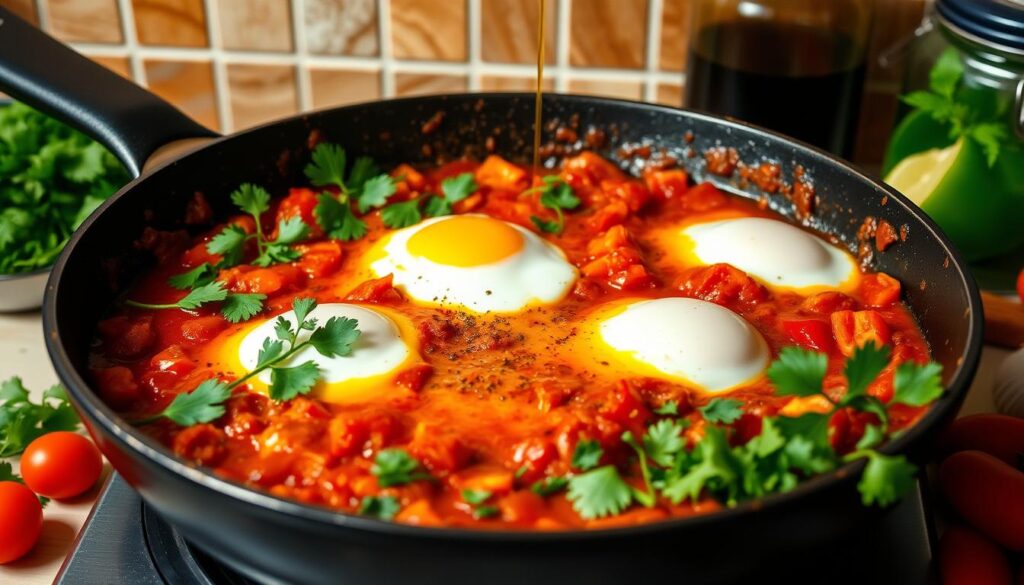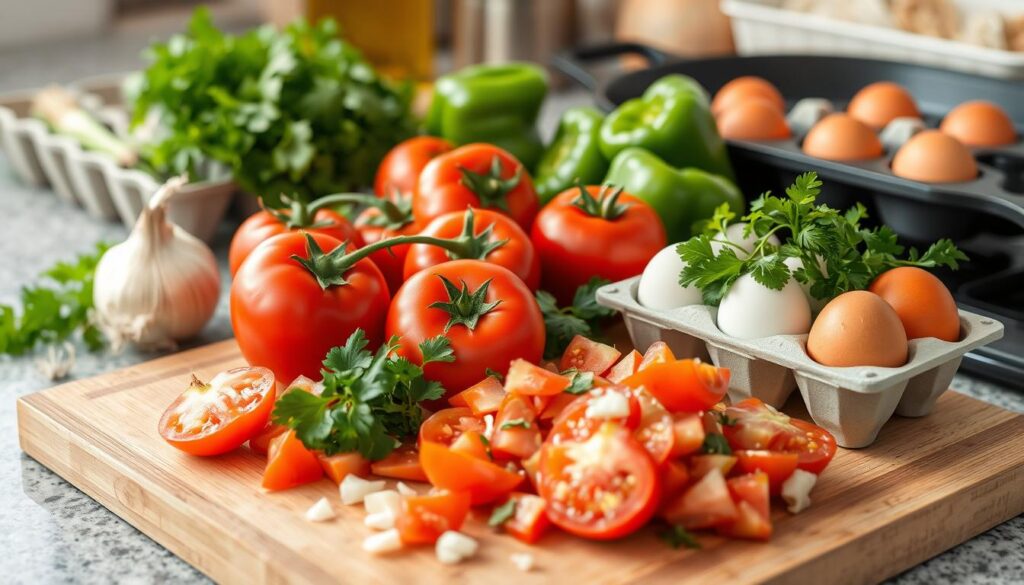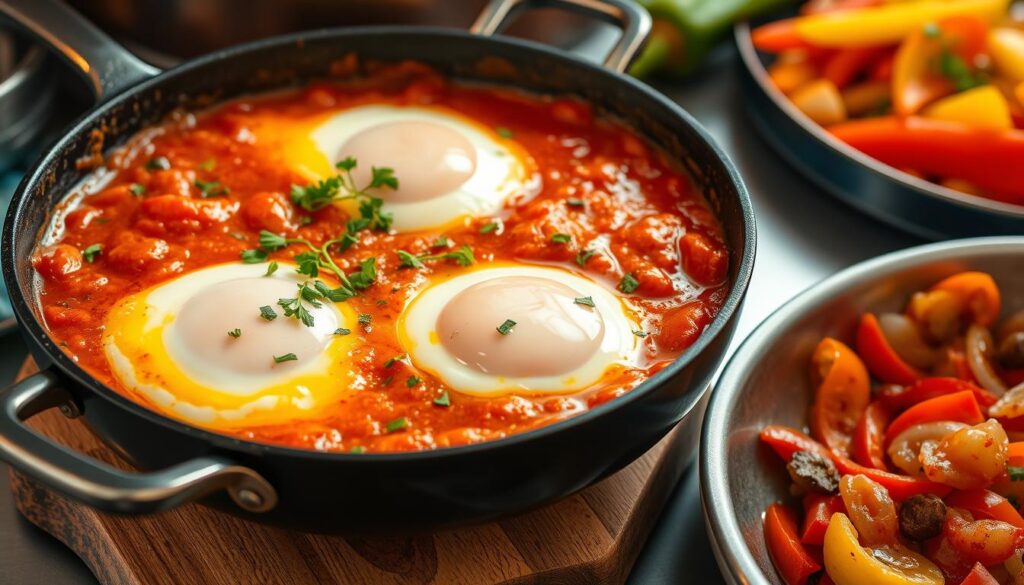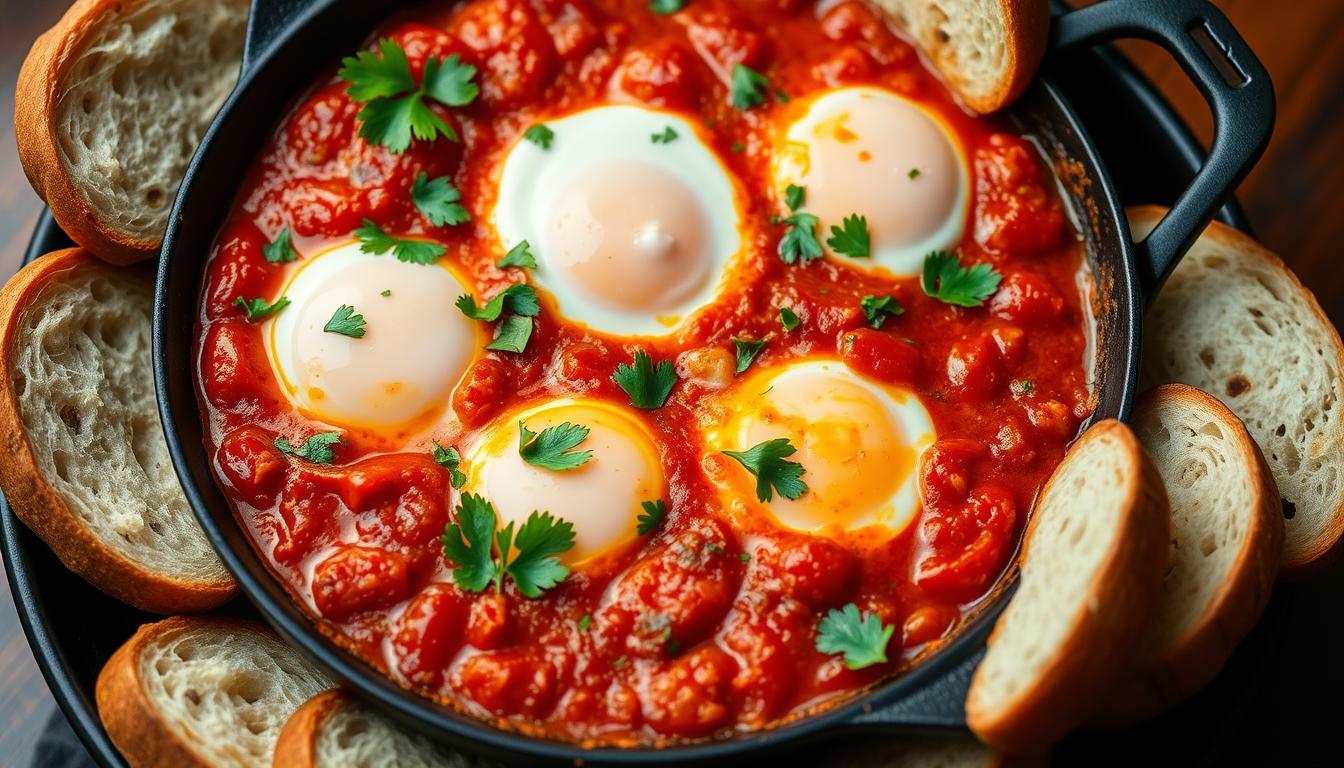Imagine a skillet full of spicy tomato sauce, with poached eggs right in the middle. The smell of Middle Eastern food fills your kitchen. Shakshuka is more than a meal; it’s an experience that turns simple ingredients into something amazing.
This dish from the Middle East is a journey for your taste buds. It’s called “a haphazard mixture” in Arabic. It combines poached eggs with a vibrant tomato sauce, ready in just 30 minutes.
Looking for a hearty breakfast, a quick brunch, or a tasty dinner? Shakshuka is your answer. Its rich flavors and easy prep make it a favorite around the world.
Key Takeaways
- Learn to make an authentic Middle Eastern shakshuka in 30 minutes
- Discover the versatility of poached eggs in a spicy tomato sauce
- Explore a nutritious meal with approximately 170 calories per serving
- Master the art of creating restaurant-quality Middle Eastern cuisine at home
- Understand the cultural significance behind this beloved dish
Understanding the Middle Eastern Breakfast Classic
Shakshuka is a key part of middle eastern cuisine that has won hearts around the world. It started in Tunisia and has a story that spans North Africa and the Mediterranean.

The name “Shakshuka” means “a mixture” in Arabic. It perfectly shows how its ingredients come together. Its rise from a local dish to a global favorite shows its wide appeal.
Origins and Cultural Significance
Shakshuka is deeply rooted in Israeli cuisine. It has a rich history. Jewish immigrants from North Africa brought it to Israel, making it a staple.
- Originated in Tunisia during the Ottoman Empire
- Integral part of the mediterranean diet
- Symbolizes culinary cross-cultural exchange
Why Shakshuka Became a Global Phenomenon
Its popularity comes from its simplicity, affordability, and rich taste. Shakshuka is a nutritious, affordable meal that people from all walks of life enjoy.
Traditional vs Modern Variations
Traditional Shakshuka stays true to its origins. But, modern chefs add their own twist. They use ingredients like feta cheese, chickpeas, and proteins, showing the dish’s flexibility.
“Shakshuka is more than a meal—it’s a culinary journey through history and culture.” – Anonymous Chef
About 80% of Israeli restaurants now serve Shakshuka. This shows its big cultural impact and ongoing evolution in the world of food.
Essential Ingredients for Authentic Shakshuka

Making real shakshuka begins with picking the best ingredients. It needs top-notch tomato sauces and fresh veggies. These add amazing depth and taste to your dish.
The main parts of a true shakshuka are:
- Ripe tomatoes or canned crushed tomatoes
- Fresh bell peppers (best if they’re red or yellow)
- Onions and garlic
- Large eggs
- Olive oil
Spices are key to making a simple tomato sauce into a fantastic shakshuka. Your spice mix should have:
- Cumin
- Smoked paprika
- Ground coriander
- Red pepper flakes
For more flavor, add harissa paste for a spicy touch. Feta cheese adds a tangy taste to the rich tomato sauce.
“The magic of shakshuka lies in its simple yet powerful ingredient combination.” – Middle Eastern Cooking Expert
| Ingredient | Quantity | Purpose |
|---|---|---|
| Crushed Tomatoes | 28 oz | Base sauce |
| Bell Peppers | 1 cup chopped | Flavor and texture |
| Eggs | 4-6 large | Protein source |
| Feta Cheese | 1/3 cup | Optional garnish |
The quality of your ingredients really matters. Fresh, ripe stuff and good spices make your shakshuka taste amazing.
Shakshuka (Eggs in Tomato Sauce) – Step-by-Step Guide
Making perfect one-pan meals like shakshuka needs care and love. This vegetarian dish mixes rich tomato sauce with perfectly poached eggs. It’s a simple yet elegant meal.

Let’s go through the steps to turn your kitchen into a Middle Eastern paradise.
Crafting the Flavorful Tomato Base
Begin by heating olive oil in a 12-inch skillet. Cook diced onions and bell peppers until they’re soft, about 4-6 minutes. Then, add minced garlic and cook for a minute to release its scent.
- Use 1 medium onion, chopped
- Add 1 red bell pepper, diced
- Include 2-3 cloves of garlic
- Sprinkle with cumin, paprika, and chili powder
Mastering Poached Eggs in Tomato Sauce
The key to perfect poached eggs is making small wells in the tomato sauce. Gently place each egg in these wells. This way, they cook slowly and evenly.
- Create 5-6 small indentations in the sauce
- Crack eggs carefully into each well
- Cover the skillet and cook for 8-12 minutes
- Ensure egg whites are opaque while maintaining runny yolks
Finishing Touches and Garnishes
Add fresh herbs and optional toppings to enhance your shakshuka. Sprinkle chopped parsley, crumble feta cheese, and add red pepper flakes for a spicy touch.
“Shakshuka is not just a meal, it’s an experience that connects you to centuries of culinary tradition.” – Chef Yotam Ottolenghi
Your homemade shakshuka is now ready to be enjoyed. It serves 4-6 people, with about 208 calories per serving.
Choosing the Right Cookware for Shakshuka
Choosing the right cookware is key for making delicious shakshuka. The right pan can change how your dish tastes and looks. It’s important for this tasty vegetarian dish.
For the best shakshuka, you need a special pan. Stainless steel skillets are the best choice. They don’t react with acidic tomato sauces, keeping your dish flavorful.
Recommended Cookware Options
- 10 1/2 inch Stainless Steel French Skillet
- 3 1/2 Quart Saucepan
- 3 Quart Saute Pan
Copper-infused pans cook better because they heat up fast. The Anolon Nouvelle Copper Nonstick 3-Quart Covered Saute is great. It’s safe for the oven up to 500˚F.
“Invest in quality cookware – it’s the foundation of exceptional cooking.”
Think about these things when picking your shakshuka pan:
| Feature | Importance |
|---|---|
| Heat Conductivity | Ensures even cooking |
| Non-Reactive Surface | Prevents metallic taste |
| Oven-Safe | Allows flexible cooking methods |
Cast iron pans are popular, but they might not be good with acidic sauces. A heavy stainless steel skillet is the best choice. It gives you the best cooking experience for shakshuka.
Spice Combinations and Flavor Profiles
Shakshuka is a standout in the world of spicy breakfast dishes. It’s a true gem of Middle Eastern cuisine. The dish’s magic comes from its spice mix, turning simple ingredients into a feast for the senses.
Traditional Middle Eastern Spices
The essence of Shakshuka is its spice blend. It adds depth and complexity to the dish. The main spices are:
- Cumin: Gives an earthy, warm flavor
- Paprika: Adds sweetness and color
- Harissa: Brings a spicy kick
- Ras el Hanout: A mix of many spices
Customizing Heat Levels
You can adjust the heat of your breakfast to your liking. Begin with a mild base and add more heat with:
- Fresh chili peppers
- Harissa paste
- Ground chili powder
| Spice Level | Recommended Ingredients | Heat Intensity |
|---|---|---|
| Mild | Paprika, Cumin | Low |
| Medium | Harissa, Chili Powder | Moderate |
| Spicy | Fresh Jalapeños, Extra Harissa | High |
Regional Spice Variations
Spice mixes vary across the Middle East. North African versions are often hotter. Israeli recipes might have a more balanced taste.
“Spices are the soul of Shakshuka, transforming a simple egg dish into a culinary journey.” – Middle Eastern Chef
Shakshuka’s beauty is in its flexibility. Try different spices to find your ideal spicy breakfast!
Best Serving Suggestions and Pairings
Shakshuka becomes a true culinary adventure with the right sides. It’s a vegetarian meal that comes alive with thoughtful pairings. These pairings honor the Mediterranean diet’s rich traditions.
- Whole wheat pita bread for dipping
- Fresh tomato salad with red onion and cucumber
- Creamy hummus with various flavor variations
- Mint-yogurt sauce as a cooling accompaniment
There are many ways to serve your shakshuka:
- Shakshuka Sandwich: Use whole pita, dip into the sauce, and top with fresh tomato salad
- Deconstructed plate with separate components
- Traditional communal serving style
“Creativity is key when serving shakshuka – let your culinary imagination run wild!”
| Serving Suggestion | Preparation Time | Serving Size |
|---|---|---|
| Classic Shakshuka | 20 minutes | 4 servings |
| Shakshuka with Side Salad | 25 minutes | 4 servings |
| Mediterranean Shakshuka Platter | 30 minutes | 4-6 servings |
Pro tip: Try adding halloumi cheese, kalamata olives, or spinach to your shakshuka. It’s perfect for breakfast, brunch, or dinner. These ideas will make your meal unforgettable, celebrating the Mediterranean’s vibrant flavors.
Tips for Achieving Restaurant-Quality Results
Making shakshuka like a pro at home takes skill and care. Whether you’re making brunch or trying out vegetarian dishes, this spicy breakfast needs precision. It’s all about the technique.
Top chefs know that great shakshuka begins with basic techniques. Your aim is to turn simple ingredients into a dish that looks and tastes like it’s from a restaurant.
Common Mistakes to Avoid
- Overcooking eggs, which destroys the delicate runny yolk texture
- Using low-quality tomatoes that lack depth of flavor
- Underseasoning the sauce, resulting in bland taste
- Cooking on incorrect heat settings
Professional Chef Recommendations
Seasoned chefs suggest paying attention to these key points:
- Select high-quality canned crushed tomatoes
- Balance spices carefully
- Monitor cooking times precisely
| Cooking Stage | Recommended Time | Key Technique |
|---|---|---|
| Tomato Sauce Preparation | 10-12 minutes | Medium-high heat |
| Sauce Simmering | 15-20 minutes | Medium-low heat |
| Egg Poaching | 5-8 minutes | Low heat |
Pro tip: Always taste and adjust seasonings throughout the cooking process to develop complex flavors in your shakshuka.
“Perfect shakshuka is about patience and precision” – Chef Yotam Ottolenghi
By using these expert tips, you’ll make your shakshuka a hit. It will impress everyone, just like a restaurant dish.
Making Shakshuka for Different Dietary Needs
Shakshuka is a versatile vegetarian meal that fits many dietary needs. It’s a staple of the Mediterranean diet, known for its flexibility. This makes it perfect for those with specific nutritional needs.
For vegetarian dishes, shakshuka is a great choice. It already meets vegetarian standards with eggs and vegetables. You can also make it your own by changing ingredients:
- Vegan adaptation: Replace eggs with roasted chickpeas
- Gluten-free option: Serve without bread or use gluten-free alternatives
- Low-carb modification: Reduce onions and peppers
Pro tip: Choose high-quality, farm-fresh eggs for the most authentic shakshuka experience.
“Shakshuka is not just a meal, it’s a canvas for culinary creativity” – Mediterranean Cooking Experts
Here’s a nutritional breakdown per serving:
| Nutrient | Amount |
|---|---|
| Calories | 146 kcal |
| Protein | 7g |
| Carbohydrates | 10g |
Shakshuka is great for anyone, whether you’re on a specific diet or just want to try new flavors. Its flexibility means it’s always a tasty and nutritious choice.
Storage and Reheating Guidelines
Mastering one-pan meals like shakshuka means knowing how to store and reheat it. This keeps the dish’s flavor and texture great while keeping it safe to eat.
To store shakshuka, keep the tomato sauce and eggs separate. You can refrigerate the sauce for 3-4 days in a sealed container. Pro tip: Keep the eggs and sauce apart until you’re ready to serve!
Reheating Methods
- Skillet Method: Warm sauce on medium heat, stirring occasionally
- Microwave Option: Heat for 1-2 minutes until thoroughly warm
- Oven Technique: Reheat at 350°F for approximately 15 minutes
For the best results, add fresh eggs when reheating. This keeps the yolk runny, just like in classic shakshuka. Add some extra feta or herbs to refresh the taste of your brunch.
“The secret to great shakshuka is treating leftovers with the same care as the original preparation.” – Professional Chef Recommendation
Freezing Guidelines
You can freeze your shakshuka sauce for up to 3 months. Thaw it in the fridge overnight and then reheat it as you like.
| Storage Method | Duration |
|---|---|
| Refrigerated Sauce | 3-4 days |
| Frozen Sauce | Up to 3 months |
Shakshuka is best enjoyed right away, but these tips will let you enjoy it later too.
Conclusion
Shakshuka is more than a brunch dish; it’s a journey through Middle Eastern cuisine. It connects you to centuries of cooking traditions from Ottoman North Africa. With just 20 minutes of prep, you can make a meal that brings people together.
Exploring shakshuka opens up a world of flavors and stories. You can try different spices, add veggies, and explore regional twists. Whether you like it spicy or mild, each version has its own tale to tell.
Learning to make shakshuka is more than just a recipe. It’s joining a tradition that has traveled from North Africa to Israel and now to kitchens everywhere. Enjoy the simplicity and complexity of this Middle Eastern classic in your cooking.



